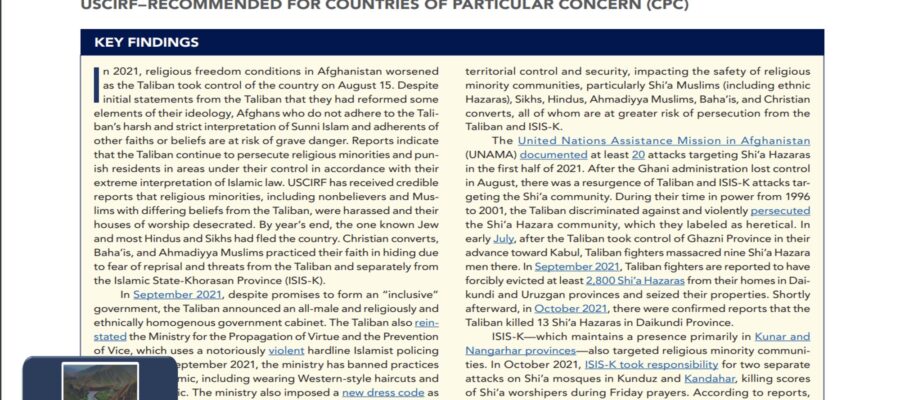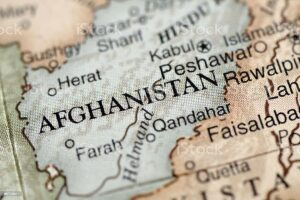The U.S. Commission on International Religious Freedom (USCIRF) has received credible reports indicating severe persecution of religious minorities in Afghanistan following the Taliban’s takeover in August 2021. Religious minorities, including nonbelievers and Muslims who do not align with the Taliban’s strict interpretation of Islam, have faced harassment and desecration of their places of worship. By the end of the year, the country’s last known Jew and most Hindus and Sikhs had fled. Christians, Baha’is, and Ahmadiyya Muslims are forced to practice their faiths in hiding due to fears of reprisal from both the Taliban and the Islamic State-Khorasan Province (ISIS-K).
Despite earlier promises to establish an inclusive government, the Taliban announced a cabinet in September 2021 that was exclusively male and religiously and ethnically homogenous. Additionally, the Taliban reinstated the Ministry for the Propagation of Virtue and the Prevention of Vice, notorious for its violent enforcement of strict Islamist codes. This ministry has banned various practices deemed un-Islamic, such as Western-style haircuts and music, and has imposed severe restrictions on women’s dress, work, education, and travel.
Under the previous Afghan government led by President Ashraf Ghani, the country already struggled with maintaining security and protecting minority communities, especially Shi’a Muslims, including ethnic Hazaras, Sikhs, Hindus, Ahmadiyya Muslims, Baha’is, and Christian converts. These groups faced significant threats from both the Taliban and ISIS-K.
The United Nations Assistance Mission in Afghanistan (UNAMA) documented at least 20 attacks against Shi’a Hazaras in the first half of 2021. Following the collapse of the Ghani administration, there was an increase in attacks by both the Taliban and ISIS-K targeting the Shi’a community. Historical animosities resurfaced as the Taliban resumed their persecution of the Shi’a Hazara community, which they had labeled heretical during their previous rule from 1996 to 2001.
In early July 2021, after taking control of Ghazni Province, Taliban fighters massacred nine Shi’a Hazara men. In September, reports emerged of Taliban fighters forcibly evicting at least 2,800 Shi’a Hazaras from their homes in Daikundi and Uruzgan provinces and seizing their properties. This was followed by confirmed reports in October that the Taliban had killed 13 Shi’a Hazaras in Daikundi Province.
ISIS-K, primarily active in Kunar and Nangarhar provinces, has also intensified its attacks on religious minority communities. In October 2021, ISIS-K claimed responsibility for two bombings targeting Shi’a mosques in Kunduz and Kandahar, which resulted in the deaths of scores of worshipers during Friday prayers. Although ISIS-K has not regained the territory it once controlled, its presence and ability to launch devastating attacks remain significant.
Afghanistan is a country with diverse ethnic groups, including Pashtuns (42%), Tajiks (27%), Hazaras (9%), Uzbeks (9%), Turkmen (3%), and Baloch (2%). The religious landscape, historically diverse, has dramatically shifted, particularly after the Taliban’s initial rise to power in 1996. The current population is overwhelmingly Muslim, with 84.7-89.7% identifying as Sunni and 10-15% as Shi’a, which includes Ismailis and Ahmadis. The few remaining non-Muslims, such as Hindus, Sikhs, Baha’is, Christians, Buddhists, and Zoroastrians, constitute only about 0.3% of the population. By the end of 2021, it appears that no Jews remain in Afghanistan.
Religious communities such as Ahmadiyya Muslims, Baha’is, and nonbelievers practice their faiths in secrecy due to the severe consequences of discovery, which can include death. Ahmadiyya Muslims, in particular, face persecution and discrimination from both Sunni and Shi’a communities. The Ahmadiyya community, estimated to number between 450 and 2,500 individuals, continues to endure societal persecution. In 2021, reports emerged of some Ahmadis being detained.
The Taliban takeover and the U.S. withdrawal from Afghanistan have precipitated widespread panic, a violent crackdown on civil society, targeted killings, detentions, severe restrictions on women’s rights, a diminished local media presence, mass exodus, and violent attacks, such as those by ISIS-K on Kabul Airport and places of worship. Religious minorities, particularly Ahmadiyya Muslims, Baha’is, and nonbelievers, remain unable to openly express their faiths due to the threats posed by the Taliban and ISIS-K.
USCIRF’s findings highlight the precarious situation for religious minorities in Afghanistan, who continue to face extreme persecution and violence under the Taliban regime.





